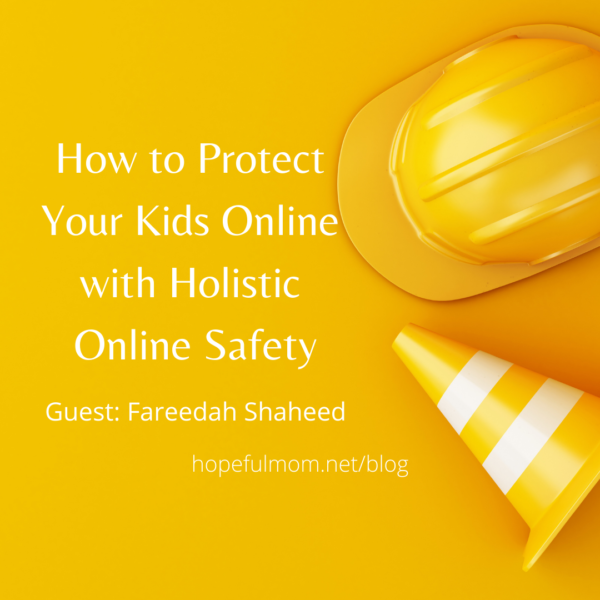We are privileged to welcome Fareedah Shaheed, also known as CyberFareedah, to Difficult Conversations. I met her at the NCOSE Summit this past summer and was immediately drawn in by her smile and upbeat personality. Fareedah approaches online safety from a positive perspective, helping parents get over the scary parts. Be sure to check out her Safe Kids Movement website.
Protecting your kids online can be a daunting task. And the rise of online crimes against children makes everything even scarier. But with the rise in fear comes a rise of hope. And to truly protect your kids online you’ll need a lot of hope, love, and patience.
This is why I believe in holistic online safety. Holistic online safety means giving your kids the freedom that they want and the safety and security that they need. Holistic online safety is the foundation of fully protecting your kids online without losing your sanity or peace. In fact, the whole premise is to make it easier for you and your kids to maintain online safety while also cultivating a beautiful relationship with each other.
There are many aspects of online safety but here are four tips that will get you started on a holistic online safety journey.
Be Your Child’s Guide and Not Their Tech Expert
For a world so focused on tech, it’s the non-tech things that actually matter in the end. So it’s important to realize that you don’t have to be tech-savvy to protect your kids online.
Your kids need guidance, not an IT Help Desk Technician. And while it does serve as a perk if you’re able to fix their computer and set up complicated internal networks to keep your kids safe, it’s not necessary for their ultimate protection online.
So before you get caught up in your potential lack of tech skills, the need to control every outcome, or the worry that you don’t know enough I encourage you to take a deep breath and remember that you’re enough.
Remember your main goal in holistic online safety is to create a foundation for a beautiful relationship and that means that you’re consistently working on building trust and a connection with your child. Not everyone will have a great relationship with their children but a foundation of mutual respect and trust can be built and that will make the world of a difference when it comes to protecting your kids in the digital age.
Your kids need a space where they feel accepted, heard, understood, and loved. This doesn’t mean you’re their friend or that you see eye to eye on everything. What this does require however is internal healing as a parent and a whole lot of faith and hope.
So before you worry about all the little details of online safety, be sure to prioritize connecting with your own self, taking care of yourself, and healing yourself so that you can better connect with your kids and holistically protect them online and offline. And none of this requires you to be tech-savvy, this just requires you to show up as your favorite self as much as possible.
Having Beautiful Conversations
The “tech talk” is not just one talk but multiple open, honest, and non-judgmental conversations. This is why I like to call them “beautiful conversations” because they prioritize lasting change and connections.
Beautiful conversations about online safety consist of:
- Mutual respect for everyone involved.
- Non-judgmental conversations. Your kids should know that they can make bad decisions without labeling themselves as a bad person.
- Your kid’s ability to voice their opinions. Without this how can your kid feel comfortable standing up to someone online or coming to you when something makes them feel uncomfortable?
- Discussion about the good, bad, ugly, and beautiful things about tech and the internet. If you tend to focus on the negative of the internet be sure to have at least 3 positive interactions/discussions about the internet with your kids (playing games with them, sharing videos, listening to their experiences, asking them curiosity-based questions about the things they love to do online).
- Stories that explain “the why.” Whenever possible it’s helpful to add stories to illustrate your point and further explain why you’ve come to a certain decision.
Parental Controls / Guidance
I intentionally put this section towards the bottom of the list because, while parental controls have their rightful place in online safety, it can never be a truly effective way to fully protect your kids online. It’s an important tool that needs to be used (specifically when they’re younger) to maintain boundaries, but it will always have a backdoor.
Parental controls have their rightful place in online safety but can never fully protect your kids online. #onlinesafety #hopefulmom #cyberfareedah How to Protect Your Kids Online with Holistic Online Safety Click To TweetAnd this backdoor is in the form of circumventing controls, a friend/classmate/family member sharing something, or a secret device/account, etc.
This isn’t a discouragement of using parental controls but a caution to understand that it’s only the icing on the cake and as they get older it will be less effective and, depending on how it’s used, it can cause friction in your relationship.
Every relationship/situation is different but for most families, parental controls are especially needed when kids are younger and may accidentally press something or stumble across something that can do mental, spiritual, or emotional damage.
Parental controls are normally found in the settings of apps/devices and you should always look to enable them along with security and privacy controls. These three controls (parental, security, and privacy) are foundational settings that you MUST look into before installing yet another app or device in your household.
Three things all your accounts should have:
– Two-factor authentication: a second way of authenticating to an account
– Strong passwords: create long and unique passwords
– Password managers like LastPass, 1Password, or Keeper can store your passwords for you so that it’s easier to retrieve and more secure for you and your family. This will make it harder for an online predator or hacker to get into your accounts.
There are also third-party parental control options like Qustodio or Netnanny. If you decide to enable parental controls then be sure to let your kids know and explain to them why it’s enabled. They should understand that you’re using these controls for their own protection.
Building Your Village / Getting Support

We all know it takes a village to raise a child. So, when it comes to online safety and security, know that you were never meant to know everything or do this alone.
Remember that you never have to be tech-savvy or know more than your kids to protect them online. All you need is to invest in your own healing and education so that you can cultivate a better relationship/connection with your kids and slowly implement better security into your family’s life.
When it comes to digital parenting, receiving consistent support and guidance along the way is essential. The Safe Kids Movement is an all-in-one resource center I created specifically to give you holistic online safety guidance and support. Support like this is important because online safety should never be a burden that you have to carry the weight of. Having a village of people to help you and give you tips and advice (like this article and the HopefulMom Community) is essential for you and your family.
About the author

Fareedah Shaheed
Fareedah Shaheed is the CEO and Founder of Sekuva, where she helps parents and caretakers protect their kids online. She has taught thousands of people online security & safety, has hosted lunch and learns, and has delivered keynotes on the subject.
She is a Forbes 30 Under 30 honoree and is currently serving on the Forbes board for the Under 30 community.
She has been named Cybersecurity Personality of the Year 2020. And her work has been featured in Cisco, NASA, FOX 25, FOX 46, FOX Carolina, The Grio, Yahoo!, AfroTech, The Every Mom, StartPage, TripWire, Infosecurity Magazine, Thales Cloud Security, and many more.


